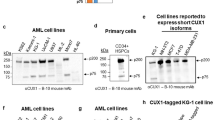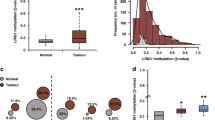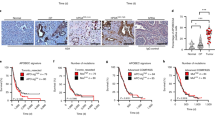Abstract
The critical 8p22 tumor suppressor deleted in liver cancer 1 (DLC1) is frequently inactivated by aberrant CpG methylation and/or genetic deletion and implicated in tumorigeneses of multiple tumor types. Here, we report the identification and characterization of its new isoform, DLC1 isoform 4 (DLC1-i4). This novel isoform encodes an 1125-aa (amino acid) protein with distinct N-terminus as compared with other known DLC1 isoforms. Similar to other isoforms, DLC1-i4 is expressed ubiquitously in normal tissues and immortalized normal epithelial cells, suggesting a role as a major DLC1 transcript. However, differential expression of the four DLC1 isoforms is found in tumor cell lines: Isoform 1 (longest) and 3 (short thus probably nonfunctional) share a promoter and are silenced in almost all cancer and immortalized cell lines, whereas isoform 2 and 4 utilize different promoters and are frequently downregulated. DLC1-i4 is significantly downregulated in multiple carcinoma cell lines, including 2/4 nasopharyngeal, 8/16 (50%) esophageal, 4/16 (25%) gastric, 6/9 (67%) breast, 3/4 colorectal, 4/4 cervical and 2/8(25%) lung carcinoma cell lines. The functional DLC1-i4 promoter is within a CpG island and is activated by wild-type p53. CpG methylation of the DLC1-i4 promoter is associated with its silencing in tumor cells and was detected in 38–100% of multiple primary tumors. Treatment with 5-aza-2′-deoxycytidine or genetic double knockout of DNMT1 and DNMT3B led to demethylation of the promoter and reactivation of its expression, indicating a predominantly epigenetic mechanism of silencing. Ectopic expression of DLC1-i4 in silenced tumor cells strongly inhibited their growth and colony formation. Thus, we identified a new isoform of DLC1 with tumor suppressive function. The differential expression of various DLC1 isoforms suggests interplay in modulating the complex activities of DLC1 during carcinogenesis.
This is a preview of subscription content, access via your institution
Access options
Subscribe to this journal
Receive 50 print issues and online access
$259.00 per year
only $5.18 per issue
Buy this article
- Purchase on Springer Link
- Instant access to full article PDF
Prices may be subject to local taxes which are calculated during checkout






Similar content being viewed by others
References
Altschul SF, Gish W, Miller W, Myers EW, Lipman DJ . (1990). Basic local alignment search tool. J Mol Biol 215: 403–410.
Bannai H, Tamada Y, Maruyama O, Nakai K, Miyano S . (2002). Extensive feature detection of N-terminal protein sorting signals. Bioinformatics 18: 298–305.
Bernards A . (2003). GAPs galore! A survey of putative Ras superfamily GTPase activating proteins in man and Drosophila. Biochim Biophys Acta 1603: 47–82.
Bourdon JC, Fernandes K, Murray-Zmijewski F, Liu G, Diot A, Xirodimas DP et al. (2005). p53 isoforms can regulate p53 transcriptional activity. Genes Dev 19: 2122–2137.
Bullock AN, Fersht AR . (2001). Rescuing the function of mutant p53. Nat Rev Cancer 1: 68–76.
Cartharius K, Frech K, Grote K, Klocke B, Haltmeier M, Klingenhoff A et al. (2005). MatInspector and beyond: promoter analysis based on transcription factor binding sites. Bioinformatics 21: 2933–2942.
Cheung WY, Chan AC, Loke SL, Srivastava G, Pittaluga S, Lim LY et al. (1993). Latent sites of Epstein-Barr virus infection. Am J Clin Pathol 100: 502–506.
Ching YP, Wong CM, Chan SF, Leung TH, Ng DC, Jin DY et al. (2003). Deleted in liver cancer (DLC) 2 encodes a RhoGAP protein with growth suppressor function and is underexpressed in hepatocellular carcinoma. J Biol Chem 278: 10824–10830.
Claros MG, Vincens P . (1996). Computational method to predict mitochondrially imported proteins and their targeting sequences. European Journal of Biochemistry 241: 779–786.
Cui Y, Ying Y, van Hasselt A, Ng KM, Yu J, Zhang Q et al. (2008). OPCML is a broad tumor suppressor for multiple carcinomas and lymphomas with frequently epigenetic inactivation. PLoS ONE 3: e2990.
Durkin ME, Ullmannova V, Guan M, Popescu NC . (2007a). Deleted in liver cancer 3 (DLC-3), a novel Rho GTPase-activating protein, is downregulated in cancer and inhibits tumor cell growth. Oncogene 26: 4580–4589.
Durkin ME, Yuan BZ, Zhou X, Drazen BZ, Douglas RL, Thorgeirsson SS et al. (2007b). DLC-1:a Rho GTPase-activating protein and tumour suppressor. Journal of Cellular and Molecular Medicine 11: 1185–1207.
Efeyan A, Serrano M . (2007). p53: guardian of the genome and policeman of the oncogenes. Cell Cycle 6: 1006–1010.
Emanuelsson O, Brunak S, von Heijne G, Nielsen H . (2007). Locating proteins in the cell using TargetP, SignalP and related tools. Nat Protocols 2: 953–971.
Fearon ER, Vogelstein B . (1990). A genetic model for colorectal tumorigenesis. Cell 61: 759–767.
Flicek P, Aken BL, Ballester B, Beal K, Bragin E, Brent S et al. (2010). Ensembl's 10th year. Nucl Acids Res 38: D557–D562.
Goodison S, Yuan J, Sloan D, Kim R, Li C, Popescu NC et al. (2005). The RhoGAP protein DLC-1 functions as a metastasis suppressor in breast cancer cells. Cancer Res 65: 6042–6053.
Guda C, Fahy E, Subramaniam S . (2004a). MITOPRED: a genome-scale method for prediction of nucleus-encoded mitochondrial proteins. Bioinformatics 20: 1785–1794.
Guda C, Guda P, Fahy E, Subramaniam S . (2004b). MITOPRED: a web server for the prediction of mitochondrial proteins. Nucl Acids Res 32: W372–W374.
Hall TA . (1999). Bioedit: A user friendly biological sequence alignment editor and analysis program for Windows 95/98/NT. Nucl Acids Symp Ser 41: 95–98.
Heinemeyer T, Chen X, Karas H, Kel AE, Kel OV, Liebich I et al. (1999). Expanding the TRANSFAC database towards an expert system of regulatory molecular mechanisms. Nucleic Acids Res 27: 318–322.
Heinemeyer T, Wingender E, Reuter I, Hermjakob H, Kel AE, Kel OV et al. (1998). Databases on transcriptional regulation: TRANSFAC, TRRD and COMPEL. Nucleic Acids Res 26: 362–367.
Herman JG, Baylin SB . (2003). Gene silencing in cancer in association with promoter hypermethylation. N Engl J Med 349: 2042–2054.
Homma Y, Emori Y . (1995). A dual functional signal mediator showing RhoGAP and phospholipase C-delta stimulating activities. EMBO J 14: 286–291.
Horii A, Nakatsuru S, Ichii S, Nagase H, Nakamura Y . (1993). Multiple forms of the APC gene transcripts and their tissue-specific expression. Hum Mol Genet 2: 283–287.
Jones PA, Baylin SB . (2007). The epigenomics of cancer. Cell 128: 683–692.
Jones PA, Laird PW . (1999). Cancer epigenetics comes of age. Nat Genet 21: 163–167.
Kim TY, Jong HS, Song SH, Dimtchev A, Jeong SJ, Lee JW et al. (2003). Transcriptional silencing of the DLC-1 tumor suppressor gene by epigenetic mechanism in gastric cancer cells. Oncogene 22: 3943–3951.
Knudson AG . (2001). Two genetic hits (more or less) to cancer. Nat Rev Cancer 1: 157–162.
Ko FC, Yeung YS, Wong CM, Chan LK, Poon RT, Ng IO et al. (2010). Deleted in liver cancer 1 isoforms are distinctly expressed in human tissues, functionally different and under differential transcriptional regulation in hepatocellular carcinoma. Liver International 30: 139–148.
Kozak M . (1986). Point mutations define a sequence flanking the AUG initiator codon that modulates translation by eukaryotic ribosomes. Cell 44: 283–292.
Kozak M . (1987). An analysis of 5′-noncoding sequences from 699 vertebrate messenger RNAs. Nucleic Acids Res 15: 8125–8148.
Larkin MA, Blackshields G, Brown NP, Chenna R, McGettigan PA, McWilliam H et al. (2007). Clustal W and Clustal × version 2.0. Bioinformatics 23: 2947–2948.
Leung TH, Ching YP, Yam JW, Wong CM, Yau TO, Jin DY et al. (2005). Deleted in liver cancer 2 (DLC2) suppresses cell transformation by means of inhibition of RhoA activity. Proc Natl Acad Sci USA 102: 15207–15212.
Lo AK, Lo KW, Tsao SW, Wong HL, Hui JW, To KF et al. (2006). Epstein-Barr virus infection alters cellular signal cascades in human nasopharyngeal epithelial cells. Neoplasia 8: 173–180.
Maglott D, Ostell J, Pruitt KD, Tatusova T . (2007). Entrez gene: gene-centered information at NCBI. Nucleic Acids Res 35: D26–D31.
Martin GS . (2003). Cell signaling and cancer. Cancer Cell 4: 167–174.
Moon SY, Zheng Y . (2003). Rho GTPase-activating proteins in cell regulation. Trends Cell Biol 13: 13–22.
Ng IO, Liang ZD, Cao L, Lee TK . (2000). DLC-1 is deleted in primary hepatocellular carcinoma and exerts inhibitory effects on the proliferation of hepatoma cell lines with deleted DLC-1. Cancer Res 60: 6581–6584.
Pang JC, Chang Q, Chung YF, Teo JG, Poon WS, Zhou LF et al. (2005). Epigenetic inactivation of DLC-1 in supratentorial primitive neuroectodermal tumor. Hum Pathol 36: 36–43.
Ponting CP, Aravind L . (1999). START: a lipid-binding domain in StAR, HD-ZIP and signalling proteins. Trends Biochem Sci 24: 130–132.
Qiu GH, Tan LK, Loh KS, Lim CY, Srivastava G, Tsai ST et al. (2004). The candidate tumor suppressor gene BLU, located at the commonly deleted region 3p21.3, is an E2F-regulated, stress-responsive gene and inactivated by both epigenetic and genetic mechanisms in nasopharyngeal carcinoma. Oncogene 23: 4793–4806.
Rhee I, Bachman KE, Park BH, Jair KW, Yen RW, Schuebel KE et al. (2002). DNMT1 and DNMT3b cooperate to silence genes in human cancer cells. Nature 416: 552–556.
Sabbir MG, Wigle N, Loewen S, Gu Y, Buse C, Hicks GG et al. (2010). Identification and characterization of Dlc1 isoforms in the mouse and study of the biological function of a single gene trapped isoform. BMC Biology 8: 17.
Sekimata M, Kabuyama Y, Emori Y, Homma Y . (1999). Morphological changes and detachment of adherent cells induced by p122, a GTPase-activating protein for Rho. J Biol Chem 274: 17757–17762.
Seng TJ, Low JSW, Li H, Cui Y, Goh HK, Wong MLY et al. (2007). The major 8p22 tumor suppressor DLC1 is frequently silenced by methylation in both endemic and sporadic nasopharyngeal, esophageal, and cervical carcinomas, and inhibits tumor cell colony formation. Oncogene 26: 934–944.
Small IF, Peeters NF, Legeai FF, Lurin C . (2004). Predotar: a tool for rapidly screening proteomes for N-terminal targeting sequences. PROTEOMICS 4: 1581–1590.
Takai D, Jones PA . (2002). Comprehensive analysis of CpG islands in human chromosomes 21 and 22. Proc Natl Acad Sci USA 99: 3740–3745.
Takai D, Jones PA . (2003). The CpG island searcher: a new WWW resource. In Silico Biol 3: 235–240.
Tao Q, Huang H, Geiman TM, Lim CY, Fu L, Qiu GH et al. (2002). Defective de novo methylation of viral and cellular DNA sequences in ICF syndrome cells. Hum Mol Genet 11: 2091–2102.
Tao Q, Robertson KD, Manns A, Hildesheim A, Ambinder RF . (1998). Epstein-Barr virus (EBV) in endemic Burkitt's lymphoma: molecular analysis of primary tumor tissue. Blood 91: 1373–1381.
Tao Q, Swinnen LJ, Yang J, Srivastava G, Robertson KD, Ambinder RF . (1999). Methylation status of the Epstein-Barr virus major latent promoter C in iatrogenic B cell lymphoproliferative disease. Application of PCR-based analysis. Am J Pathol 155: 619–625.
Tcherkezian J, Lamarche-Vane N . (2007). Current knowledge of the large RhoGAP family of proteins. Biol Cell 99: 67–86.
Tsao SW, Wang X, Liu Y, Cheung YC, Feng H, Zheng Z et al. (2002). Establishment of two immortalized nasopharyngeal epithelial cell lines using SV40 large T and HPV16E6/E7 viral oncogenes. Biochim Biophys Acta 1590: 150–158.
Wong CM, Lee JM, Ching YP, Jin DY, Ng IO . (2003). Genetic and epigenetic alterations of DLC-1 gene in hepatocellular carcinoma. Cancer Res 63: 7646–7651.
Xu CF, Brown MA, Chambers JA, Griffiths B, Nicolai H, Solomon E . (1995). Distinct transcription start sites generate two forms of BRCA1 mRNA. Hum Mol Genet 4: 2259–2264.
Xue W, Krasnitz A, Lucito R, Sordella R, VanAelst L, Cordon-Cardo C et al. (2008). The ITGB2 immunomodulatory gene (CD18), enterocolitis, and Hirschsprung's disease. Genes & Development 22: 1439–1444.
Ying J, Li H, Seng TJ, Langford C, Srivastava G, Tsao SW et al. (2005a). Functional epigenetics identifies a protocadherin PCDH10 as a candidate tumor suppressor for nasopharyngeal, esophageal and multiple other carcinomas with frequent methylation. Oncogene 25: 1070–1080.
Ying J, Srivastava G, Hsieh WS, Gao Z, Murray P, Liao SK et al. (2005b). The stress-responsive gene GADD45G is a functional tumor suppressor, with its response to environmental stresses frequently disrupted epigenetically in multiple tumors. Clin Cancer Res 11: 6442–6449.
Yuan BZ, Durkin ME, Popescu NC . (2003). Promoter hypermethylation of DLC-1, a candidate tumor suppressor gene, in several common human cancers. Cancer Genet Cytogenet 140: 113–117.
Yuan BZ, Jefferson AM, Baldwin KT, Thorgeirsson SS, Popescu NC, Reynolds SH . (2004). DLC-1 operates as a tumor suppressor gene in human non-small cell lung carcinomas. Oncogene 23: 1405–1411.
Yuan BZ, Jefferson AM, Millecchia L, Popescu NC, Reynolds SH . (2007). Morphological changes and nuclear translocation of DLC1 tumor suppressor protein precede apoptosis in human non-small cell lung carcinoma cells. Exp Cell Res 313: 3868–3880.
Yuan BZ, Miller MJ, Keck CL, Zimonjic DB, Thorgeirsson SS, Popescu NC . (1998). Cloning, characterization, and chromosomal localization of a gene frequently deleted in human liver cancer (DLC-1) homologous to rat RhoGAP. Cancer Res 58: 2196–2199.
Yutaka Akiyama, TFSEARCH: searching transcription factor binding sites, 1995 Ref Type: Unpublished Work.
Zhou X, Thorgeirsson SS, Popescu NC . (2004). Restoration of DLC-1 gene expression induces apoptosis and inhibits both cell growth and tumorigenicity in human hepatocellular carcinoma cells. Oncogene 23: 1308–1313.
Zhou X, Wang XW, Xu L, Hagiwara K, Nagashima M, Wolkowicz R et al. (1999). COOH-terminal domain of p53 modulates p53-mediated transcriptional transactivation, cell growth, and apoptosis. Cancer Res 59: 843–848.
Acknowledgements
This project was supported by an A*STAR grant (Johns Hopkins Singapore, QT/WS/RA), a Chinese University of Hong Kong grant (QT) and a grant from Singapore National Research Foundation and the Ministry of Education under the Research Center of Excellence Program (WS/RA). We thank Drs Bert Vogelstein, George Tsao, (Dolly Huang), Michael Obster and Guiyuan Li for some cell lines; and DSMZ (German Collection of Microorganisms & Cell Cultures) for the KYSE cell lines (Shimada et al., Cancer 69: 277–284, 1992). We also thank Drs Wenling Han, Thomas Putti, Luke Tan for some tumor samples.
Author information
Authors and Affiliations
Corresponding authors
Ethics declarations
Competing interests
The authors declare no conflict of interest.
Additional information
Supplementary Information accompanies the paper on the Oncogene website
Rights and permissions
About this article
Cite this article
Low, J., Tao, Q., Ng, K. et al. A novel isoform of the 8p22 tumor suppressor gene DLC1 suppresses tumor growth and is frequently silenced in multiple common tumors. Oncogene 30, 1923–1935 (2011). https://doi.org/10.1038/onc.2010.576
Received:
Revised:
Accepted:
Published:
Issue Date:
DOI: https://doi.org/10.1038/onc.2010.576
Keywords
This article is cited by
-
LINC00114 stimulates growth and glycolysis of esophageal cancer cells by recruiting EZH2 to enhance H3K27me3 of DLC1
Clinical Epigenetics (2022)
-
Proteasomal turnover of the RhoGAP tumor suppressor DLC1 is regulated by HECTD1 and USP7
Scientific Reports (2022)
-
Functional antagonism between CagA and DLC1 in gastric cancer
Cell Death Discovery (2022)
-
Nuclear DLC1 exerts oncogenic function through association with FOXK1 for cooperative activation of MMP9 expression in melanoma
Oncogene (2020)
-
The tumor suppressor DLC1 inhibits cancer progression and oncogenic autophagy in hepatocellular carcinoma
Laboratory Investigation (2018)



